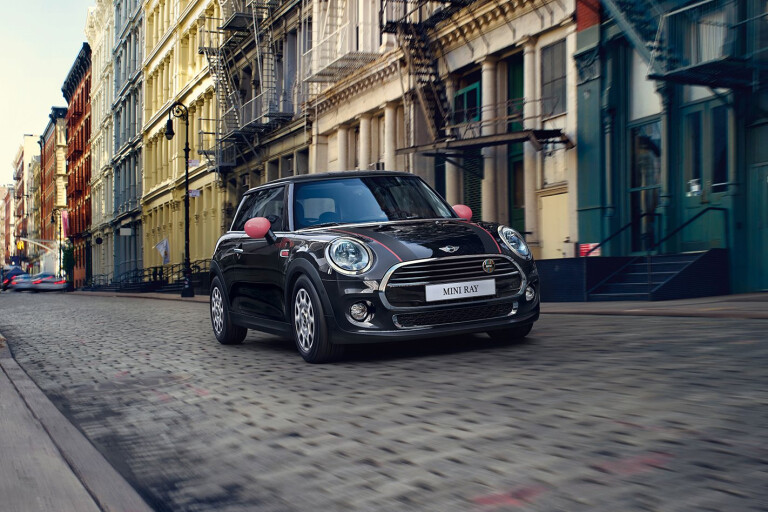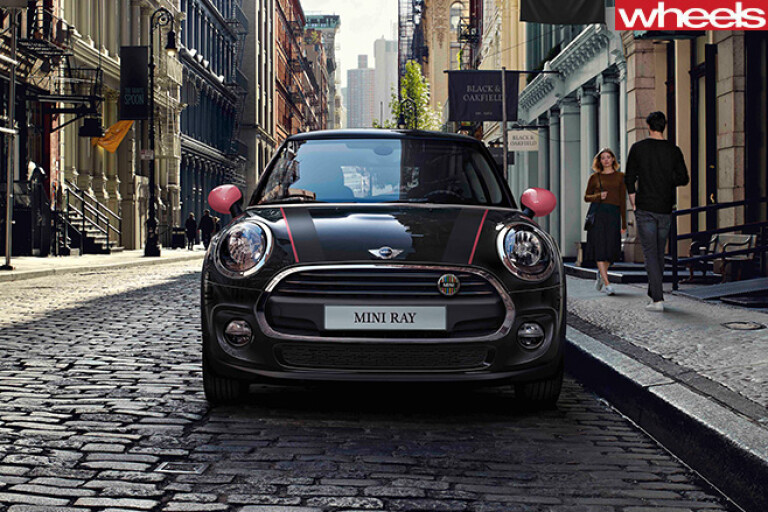
Want all the style of a Mini Cooper but shy away from the premium price tag? There’s now a cheaper option that looks the part, as long as you don’t look too closely.
WHAT IS IT?
Mini’s former price leader, the $24,950 Mini One, has gone. In its place is the Mini Ray, a badge last seen here in 2013. The Ray is available as either the three-door tested here, or a five-door, and carries over the One’s 1.2-litre turbo three-cylinder engine.
WHY WE'RE TESTING IT
The Mini Ray costs a little more than the Mini One – the car it replaces – but includes a few nice, formerly optional touches that help to disguise its cheapness. Does the lower price tag also mean a cut-down implementation of the traditional Mini fun-to-drive ethos?
MAIN RIVALS
Audi A1 1.2 TFSI Attraction, Fiat 500 Lounge, Hyundai Veloster Plus, Renault Clio GT Premium
THE WHEELS VERDICT
Cheaper isn’t always better, and despite its veiled efforts to look more upmarket, the Mini Ray is a prime example. The Ray misses out on significant performance and equipment compared with the Cooper. Once the drive-away pricing honeymoon ends, the price difference between Mini’s entry-level model and the next rung up the product ladder will be too small to justify it.
PLUS: Smoothest ride of any Mini; polished interior; exterior enhancements disguise some of the cheapness
MINUS: Runs on less-grippy eco tyres; no reversing camera or cruise control; dated head unit graphics; struggles on value compared with a bigger-engined, better equipped Cooper

THE WHEELS REVIEW
THERE’S a new cheap Mini in town. The price-leading One has gone, and in its place comes the Ray, Mini’s name used for the original cut-price version of the Cooper hatch launched in 2001 under BMW’s stewardship.
On paper, the $25,922 Mini Ray is only $658 behind the list price of the better-equipped base Cooper, although at $29,000 drive-away the honeymoon price for the Ray represents about a $2000 saving over the Cooper once on-road costs are factored in.
Outside, the stand-out cheap sign it’s a Mini Ray are the plastic hubcaps hiding 15-inch steel rims. However, a big, bright visual lift comes from the Ray’s default styling package that includes a colour-coded bonnet stripe, mirror covers and side scuttle in green, yellow or pink.
Part of the Mini experience we’ve always loved is the pep bed into it. The Ray’s engine misses out on the BMW-sourced Valvetronic variable valve technology that can adjust valve lift on the fly to eke out fuel savings, but it does get variable camshaft control for the intake and exhaust valves, and a stop-start function.
Its smaller 1.2-litre turbocharged three-cylinder engine only produces three-quarters of the power of the Cooper’s larger 1.5-litre triple, making 75kW and 180Nm. Fuel use for the Ray is officially rated at 4.9L/100km – 0.2L/100km higher than for the higher-displacement Cooper.
Inside, the Ray feels a bit mean. It only has single-zone climate control air conditioning, everything from lights to wipers to seat adjustments are manually operated, and the blocky red radio head unit graphics are more at home on a 1980s-era, 16-bit calculator screen.
The steering wheel lets things down. It has only two spokes, not the usual Mini three, and there are no buttons on it, as there is no cruise control. It also means the multimedia system needs to be adjusted via fiddly controls on the head unit.
There’s the usual Mini polish, though. The Ray’s fit and finish is impeccable, the switchgear feels nicely tactile, there’s Bluetooth and a USB port, the cloth seats come straight out of the Cooper, and the thrummy 1.2 turbo oozes character with revs on board.
Spend an extra couple of thou to step up to the Cooper and it brings much more. Compared with the Ray, the Cooper adds the bigger 100kW/220Nm 1.5-litre engine, 15-inch alloys, a height-adjust passenger seat, three-spoke steering wheel that links to both the audio system and adaptive cruise control, access to a much better list of interior highlights, more small item cabin and boot storage options, front fog lights, rain-sensing wipers, LED interior lights that flick through a rainbow of colours, and tyre pressure monitors. The Ray is also locked out from a number of Mini’s equipment packages designed to make it more liveable as a daily commuter car.
On the road, the Ray feels sluggish off the mark compared with the regular Mini. We tested the six-speed auto version that replaces the default six-speed manual for an extra $2350. The auto’s tune works well to squeeze something resembling performance out of the smaller triple when asked, but will chase low revs and fuel economy – bringing out the engine’s vibratey, lumpy worst – when off the boil.
The ride on the Ray’s 175/65 R15 Hankook Kinergy eco-rubber borders on the best in the Mini range. The high-profile tyres soak up lumpy roads well, although the tyres are noisy over coarse-chip surfaces. The rubber also lacks sufficient grip to tap that trademark go-kart handling; pitch the Ray into a tight corner and even at moderate speeds the tyres squeal excitedly like One Direction fans at a poster signing.
Mini’s Ray carries over from where the One has left off, complete with the not-quite-all-there Mini experience. It’s a little more exxy, and hides its cheapness a bit better. But if you can afford the extra $2K, the more authentic choice is always going to be the more richly equipped Cooper.
SPECS
Model: Mini Ray
Engine: 1198cc 3-cyl, dohc, 12v, turbo
Max power: 75kW @ 4250rpm
Max torque: 180Nm @ 1400-4000rpm
Transmission: 6-speed manual
Weight: 1150kg
0-100km/h: 9.9sec (claimed)
Economy: 4.9L/100km
Price: $29,000 drive-away
On sale: Now

COMMENTS